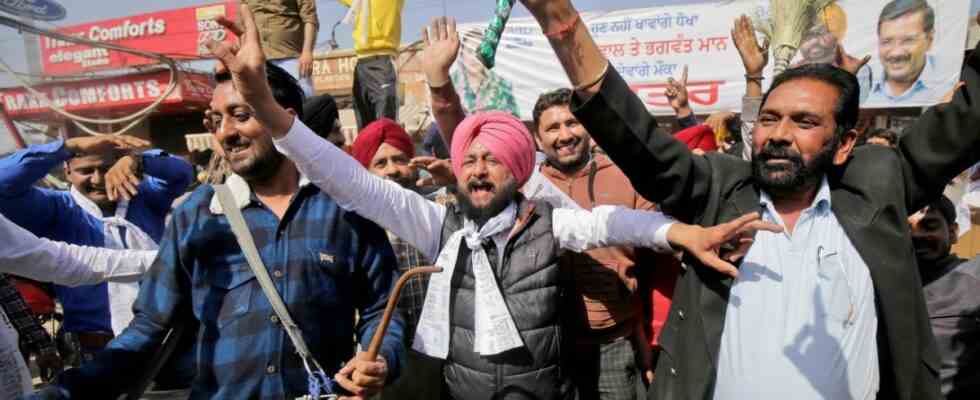Of course, these elections were also about sacred cows. How could it be different in India? They have become a problem in the largest state of Uttar Pradesh with more than 200 million inhabitants, and so they have also become a campaign issue. If the cows are too old to give milk, they used to be sold, slaughtered and exported. But the Bharatiya Janata Party (BJP), which is in power in Delhi and is also the chief minister in Uttar Pradesh, has been cracking down on the slaughter since last year as part of its Hindu nationalist policies.
Since then, around 1.6 million stray cows have been causing accidents, destroying part of the meager harvest and even attacking people. The cows, which are sacred to Hindus but not to Muslims, were not the only issue in the last election campaign, but a big one – alongside the poor pandemic management in Delhi and the rude treatment of protesting farmers. The big question was whether the BJP under Prime Minister Narendra Modi and Yogi Adityanath, the chief minister in Uttar Pradesh, would be punished for their course.
When the count began on Thursday in Uttar Pradesh, where elections had been held since February, it quickly became clear that Yogi Adityanath would remain in power. With a turnout of 56 percent, more than 60 percent of the votes went to the BJP. The party won in four of the five states that held elections. In the prosperous coastal state of Goa, it is before the National Congress, where coalition negotiations will begin. In remote Manipur, a BJP-led coalition has the most votes and will continue to govern. In the mountainous state of Uttarakhand, too, the BJP won a majority ahead of the second-placed National Congress, albeit a much smaller one than in Uttar Pradesh.
Only in Punjab did the relatively new Aam Admi Party (AAP) prevail over the National Congress with an impressive majority. She won 111 of 117 seats. The AAP had campaigned emotionally with promises of change. She accused the incumbent government of driving the Punjab to ruin, wooed voters with the prospect of falling living costs, 1,000 rupees less a month, almost twelve euros. A better infrastructure and free generators were also promised. Such very concrete promises are common in the Indian election campaign.
Anger at Modi subsided – but not everywhere
The fact that the BJP was unable to win more votes in Punjab was ultimately due to the protesting peasants. Last year they set up their largest protest camp on the border with Delhi and are deeply resentful that Modi wanted to push through his agricultural reforms without discussing them with them.
But that doesn’t explain the ruling party’s success in the even more important agricultural state of Uttar Pradesh. For the first time in decades, a party in this state is re-elected. Usually, after each legislature, people are so disappointed that they vote for someone else the next time. Last summer, the farmers in Uttar Pradesh threatened to rally behind another party, no matter which one. But then Narendra Modi withdrew the controversial agrarian reform and the anger subsided.
After the pandemic last early summer caused the Indian health system to collapse within a few days and people in Delhi suffocated in front of overcrowded hospitals, published IndiaToday a survey in August 2021: Only 24 percent of the population believed that Modi was suitable to continue to lead the country – a deterioration of 40 percent. However, Yogi Adityanath was traveling in Uttar Pradesh at the same time, could be seen and heard everywhere, promising help and often delivering it. And Adityanath is not only a very visible and approachable politician, he is also a Hindu priest.
In 2021, the BJP drafted a law on a two-child policy that is clearly aimed at Muslims in the country, who often have more offspring. In so doing, the party fueled fears among the Hindu majority that they might soon be in the minority. In addition, the BJP’s radical volunteer organization, the Rashtriya Swayamsevak Sangh (RSS), invested in a door-to-door campaign. When it comes to the intensive processing of individual population groups by the RSS, the talk in India is of the BJP’s “election machine”.
Old cows eat their grace hay in the shade
The RSS was also the driving force behind the construction of the Ayodhya Hindu Temple in Uttar Pradesh. Supported by Chief Minister Yogi Adityanath, it is being built under great security on the ruins of a burned-down mosque. Anyone who visits the RSS hostel in Ayodhya has to listen to unsolicited tirades against fellow Muslims’ family planning and that they cause trouble wherever they are in the majority. There is also a barn on the large site, where old cows stand in the shade and enjoy their last days with water and hay.

